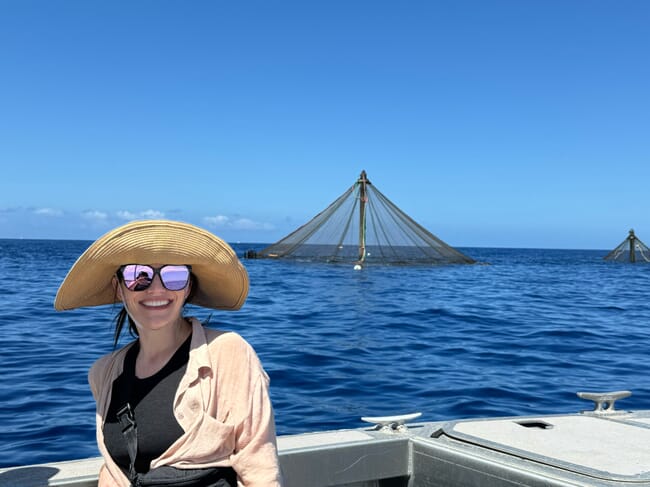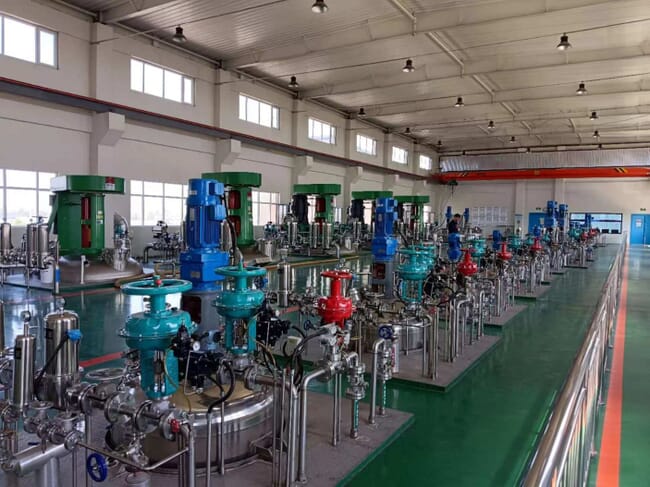
© Knip
Can you briefly describe what Knip does and what makes your product unique?
Knip has developed a precision fermentation platform that produces ingredients for aquafeeds using a natural, abundantly available microbe – if you've eaten lettuce, you've encountered our microbe. Our flagship product, JUV, is a functional ingredient designed to mitigate the effects of stressors such as handling, transfers, diseases and more. Fish and shrimp fed with diets that include up to 5 percent JUV have been proven to have higher survival rates, drastically lowering mortality. They maintain aggressive feeding habits, leading to sustained growth during and after stressful periods, more efficient use of feed, and in some cases, a reduced need for medicated feed. Stronger animals that keep eating rebound more quickly, significantly increasing productivity.
What makes JUV unique is its natural package of beneficial compounds, including anti-inflammatory compounds, antioxidants and non-pigmented carotenoids. Our production platform is also environmentally friendly – it doesn’t compete with human food, uses a fraction of the land and water compared to terrestrial agriculture, and can even be carbon-negative.
Are you targeting particular species or geographies?
Currently, our beachhead markets are salmonids and shrimp, as these are where we have farm demonstration data, paying customers and paths to scalability. However, our portfolio of in vivo trials covers a wide range of species, including both freshwater and marine, as well as warm and cold-water fish and crustaceans – all with similar results. What’s most exciting is that JUV demonstrates broad efficacy across species, so we don’t see ourselves as species-specific. Geographically, having achieved both FDA and CFIA approval, we currently sell in North America and South Asia, and we’re looking to expand into Europe and South America.
What's your value proposition?
Our monetary value proposition is simple - one of the most significant costs to a farm is feed, and ensuring that the feed investment drives better outcomes is crucial. By incorporating JUV into the feed, farmers are making a strategic investment that maximises returns.
Our on-farm trials with trout showed that, on average, JUV delivered a 17 percent increase in biomass, while it increased feed costs by less than a 1 percent.
How much JUV can you produce and how and where do you plan to scale?
Our current production capacity is about 250 tonnes per year, with projected production levels reaching four digits within the next three years. We’re in the initial stages of demand planning, where we’re carefully aligning our production ramp-up with our sales efforts to ensure we deliver on our promises or avoid overproduction. One of the core advantages of our technology is that it allows us to continue to grow by leveraging a network of contract manufacturing organizations (CMOs). We have facilities overseas, and as demand grows, so does the development of domestic production and other key geographic areas. We have a lot of flexibility and agility.

© Knip
Why did the company go quite quiet in 2020 after a lot of positive press in the 2-3 previous years?
The pandemic had a significant impact on us, both directly and indirectly. It affected our staff and forced us to go hyper-lean and laser-focused on just a few key goals. Production was particularly challenging during that time, and we were careful not to overpromise and underdeliver. As a result, the company focused on serving the market with JUV, developing key relationships that have brought us to where we are today.
What persuaded you to join Knip and what relevant experience do you bring to the role?
I was initially drawn to Knip as an early investor because I believed in the company’s mission, which at the time was to utilise precision fermentation as a tool to create biotechnological solutions for some of the world’s biggest issues, one of which was the development of a natural and sustainable source of protein. The opportunity became clear when the company developed its current flagship product, JUV, and we began to understand how much value this product could bring to aquaculture farms.
I’ve spent many years at the intersection of science, technology and business, helping to translate cutting-edge innovations into sustainable business models. With my experience in building sales teams, developing strategies for operational excellence, and extensive background in manufacturing, I can lead the team to become a commercially successful enterprise.
What have been your first impressions of the company and the aquaculture sector in general?
Knip has always maintained a strong focus on commercial viability. The company’s relentless pursuit of product-market fit has enabled it to achieve many milestones without needing to raise substantial capital – a contrast to many other companies in precision fermentation or alternative proteins. By prioritising the product, Knip found innovative ways to scale up its technology without investing in capital-intensive projects or assets. The economics are sound, and there is an immediate demand for Knip’s products.
I’m excited to serve the aquaculture sector. I have been deeply involved in land and water conservation, as well as regenerative agriculture, for many years. The future of our world hinges on ocean health and access to sustainable animal protein sources, and aquaculture is a crucial part of that puzzle. The aquaculture sector represents a true “blue ocean” opportunity. Despite its significance, relatively little capital has been directed toward innovations in this space. For example, only a handful of seed and growth funds currently focus on supporting new entrepreneurs and companies in the blue economy. However, as regulations continue to shape the sector and the value of seafood for a food-secure future becomes clearer, the opportunities here will only grow in importance and value.

The startup is initially targeting the salmon and shrimp sectors © Knip
What have been your major milestones of late?
We recently concluded a series of farm demonstrations with a major partner, which has been pivotal for us. At the same time, another long-time partner in Asia converted to repeat sales, and we recently cleared a major milestone in our production capabilities and costs. All of this happened within a few months, creating a remarkable convergence of events. It’s clear that the timing for our comeback is perfect, and we’re thrilled to be here!
We’ve also proved our production efficiencies on a scale, which confirms the accuracy of our economic analysis.
What challenges do you still need to overcome?
When it comes to feed, farmers aren’t just looking at the price tag – they’re focused on the return they get from that investment. We recognize that JUV is a premium product, but it’s not just about the upfront cost; it’s about the value it brings in terms of performance and results and what it does to improve the bottom line for farmers. Most farmers understand this and are always interested in innovations that can help them succeed.
However, it’s on us to earn their trust. The key question is: can we deliver on our promise? We’re not the first to offer a product that claims to improve survival, but we all know that not every past offering has lived up to its promises, leading to some scepticism in the market. That’s why trust is paramount. We’re committed to not only meeting expectations, but also exceeding expectations, delivering real value where it matters most.
What feedback have you had from the feed sector and farmers?
For those early adopters who were kind enough to give us a chance, the feedback has been overwhelmingly positive. From a technical and performance standpoint, to how it handles in the mill, and the value it delivers.
How are you funded and are you looking for further funding?
The bulk of our funding so far has come from non-dilutive grants and a loyal, committed group of biotech-focused angel investors and strategically aligned funds. They have been incredibly supportive of our company. We’ve recently joined Hatch Blue’s portfolio, which has been a significant value add and exemplifies the type of investors we are currently seeking. We reached an exciting inflection point; we are looking for institutional and strategic investors who understand the opportunities ahead, recognise the impact we’re making, and align with our product development pathway.
How do you see the company developing in the coming years?
We have several products in the pipeline that were put on hold during the pandemic, and we’re eager to reignite them, especially given the growing market demand. We’re also preparing the next generation of JUV. As a platform, our technology has the potential to bring a range of adjacent products to the market and we will see those opportunities open up as we continue to reduce production costs. Additionally, we’re investigating forming partnerships to produce JUV in carbon-neutral facilities. Exciting developments are on the horizon – stay tuned!




